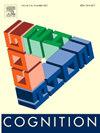Skewed distributions facilitate infants' word segmentation
IF 2.8
1区 心理学
Q1 PSYCHOLOGY, EXPERIMENTAL
引用次数: 0
Abstract
Infants can use statistical patterns to segment continuous speech into words, a crucial task in language acquisition. Experimental studies typically investigate this ability using artificial languages with a uniform frequency distribution, where all words occur equally often. However, words in natural language follow a highly skewed distribution conforming to a Zipfian power law, in which few words occur frequently while many occur infrequently. Prior work shows that such skewed distributions facilitate word segmentation, but the experimental evidence for this has been limited to individuals aged ten years or older, leaving unclear whether this effect arises from accumulated linguistic experience or is already present in the early stages of language learning. To address this, we conducted a word segmentation study with 7- to 9-month-old infants. Infants were exposed to a continuous speech stream containing four artificial words, presented either in a uniform or skewed frequency distribution. We found that infants exposed to the skewed distribution showed a greater looking time difference between familiar and unfamiliar words compared to those in the uniform condition. These findings suggest that skewed distributions facilitate learning during early linguistic development, highlighting the impact of such distributions on language acquisition. Moreover, these findings suggest that the widespread use of uniform distributions in lab-based studies may underestimate infants' segmentation abilities.
偏态分布有利于婴儿分词
婴儿可以使用统计模式将连续的语音分割成单词,这是语言习得的一项关键任务。实验研究通常使用具有均匀频率分布的人工语言来调查这种能力,其中所有单词的出现频率相同。然而,自然语言中的单词遵循高度倾斜的分布,符合Zipfian幂定律,其中少数单词经常出现,而许多单词不经常出现。先前的研究表明,这种偏斜分布有利于分词,但实验证据仅限于10岁以上的个体,尚不清楚这种影响是来自积累的语言经验,还是已经存在于语言学习的早期阶段。为了解决这个问题,我们对7到9个月大的婴儿进行了分词研究。婴儿暴露在包含四个人工单词的连续语音流中,这些单词以均匀或扭曲的频率分布呈现。我们发现,与处于均匀分布条件下的婴儿相比,处于倾斜分布条件下的婴儿在熟悉和不熟悉的单词之间表现出更大的看世界时差。这些发现表明,在早期语言发展过程中,倾斜分布促进了学习,突出了这种分布对语言习得的影响。此外,这些发现表明,在基于实验室的研究中广泛使用均匀分布可能低估了婴儿的分割能力。
本文章由计算机程序翻译,如有差异,请以英文原文为准。
求助全文
约1分钟内获得全文
求助全文
来源期刊

Cognition
PSYCHOLOGY, EXPERIMENTAL-
CiteScore
6.40
自引率
5.90%
发文量
283
期刊介绍:
Cognition is an international journal that publishes theoretical and experimental papers on the study of the mind. It covers a wide variety of subjects concerning all the different aspects of cognition, ranging from biological and experimental studies to formal analysis. Contributions from the fields of psychology, neuroscience, linguistics, computer science, mathematics, ethology and philosophy are welcome in this journal provided that they have some bearing on the functioning of the mind. In addition, the journal serves as a forum for discussion of social and political aspects of cognitive science.
 求助内容:
求助内容: 应助结果提醒方式:
应助结果提醒方式:


